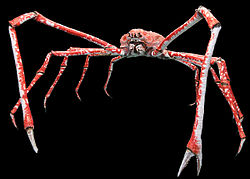Japanese spider crab
From Wikipedia, the free encyclopedia
| Japanese spider crab | ||||||||||||||||||||
|---|---|---|---|---|---|---|---|---|---|---|---|---|---|---|---|---|---|---|---|---|
 |
||||||||||||||||||||
| Conservation status | ||||||||||||||||||||
| Scientific classification | ||||||||||||||||||||
|
||||||||||||||||||||
| Binomial name | ||||||||||||||||||||
| Macrocheira kaempferi Temminck, 1836 |
The Japanese spider crab, Macrocheira kaempferi, is the largest known arthropod; fully grown it can reach a leg span of almost 4 m (13 ft), a body size of up to 37 cm (15 inches) and a weight of up to 20 kg (44 lb). The crab's natural habitat is on the bottom of the Pacific Ocean (some 300 to 400 m deep) around Japan, where it feeds on dead animals and shellfish. It is believed to have a life expectancy of up to 100 years.[1]
Currently, this is the only living species of the genus Macrocheira, but there have been two reports of other fossil specimens. M. kaempferi is named in honor of Engelbert Kaempfer, the Japan traveller and naturalist from Lemgo, Germany.
Contents |
[edit] Physical characteristics
The Japanese spider crab has 10 legs. The front two legs have been adapted into chelipeds, or claws. It has an orange body with white spots on its thin legs. In males, the limbs on which the claws are located become longer than its other limbs, and a large male can widen them to more than 3 m.[2] The oval-shaped and vertically rounded shell can reach 30 cm in width and can be up to 40 cm long. The compound eyes are situated on the front, and two thorns stick out between them. Younger specimens feature hair and thorns on the shell, and their frontal horns are longer, but these gradually atrophy as the crab ages.

[edit] Natural habitat and human impact
| This section does not cite any references or sources. Please help improve this article by adding citations to reliable sources (ideally, using inline citations). Unsourced material may be challenged and removed. (March 2009) |
The Japanese spider crabs' habitat is limited to the Pacific side of the Japanese archipelago. They often live on the seabed at depths of 150 to 800 m, but are found most prominently in depths of 200 to 300 m. In spring, they can often be found laying eggs in waters as shallow as 50 m.
The Japanese spider crab is caught using small trawling nets, and is often eaten salted and steamed. It is caught in the Sagami, Suruga, and Tosa bays and also around the Izu Islands. Catching of the crab is forbidden during the spring, when it lays its eggs.
It is considered a specialty around Suruga Bay, but numbers of the crab have diminished over recent years, and there are many efforts to protect them. In Wakayama Prefecture, the crabs are caught when they move to shallower waters in the spring.
The Japanese spider crab is also used for research and ornamental purposes. It has a gentle disposition and is often reared in aquaria.
[edit] See also
[edit] References
- ^ "Oregon Coast Aquarium". http://www.aquarium.org/JapaneseSpiderCrabs.asp.
- ^ Wood, Gerald L. (1982). The Guinness Book of Animal Facts & Feats. Enfield, Middlesex. Guinness Superlatives Ltd. ISBN 0-85112-235-3.
| Wikimedia Commons has media related to: Macrocheira kaempferi |


